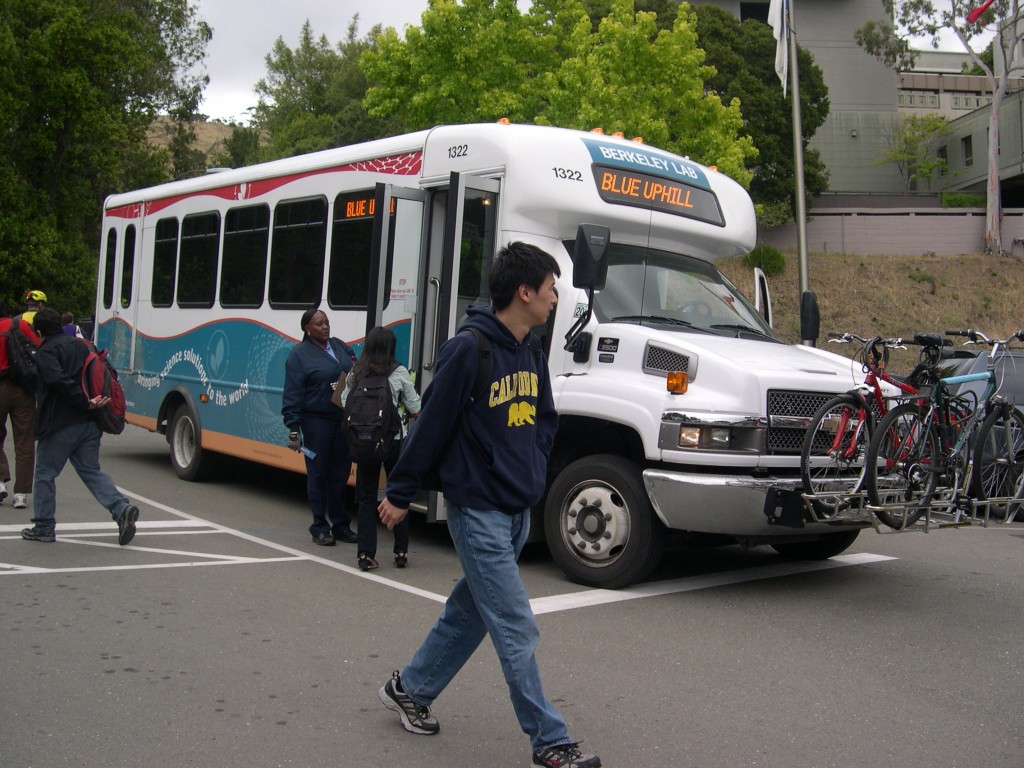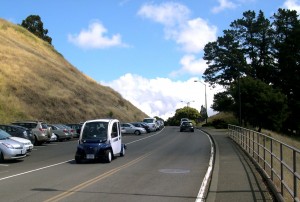Scientists at the U.S. Department of Energy’s Lawrence Berkeley National Laboratory are engaged in cutting-edge research and development of technologies that will reduce the world’s emissions of greenhouse gases. But until those technologies come to fruition, they’re reducing emissions the old-fashioned way, one less car trip at a time.
Thanks to Berkeley Lab’s fleet and transportation policies aimed at reducing car rides, only slightly more than half of the more than 4,000 employees and visiting researchers that work at Lab facilities drive to work as a single occupant. The rest commute by bike, carpool and public transit—and the numbers are growing.
“The Lab as an institution has a strong commitment to transportation for its employees,” says Jim Dahlgard, a senior business manager who oversees transportation. “We are constantly looking for new ways to encourage use of public transit and get people out of their cars.”
These efforts have taken on greater importance since 2009, when President Barack Obama issued Executive Order 13514, which set sustainability goals for federal agencies, including reducing fleet petroleum consumption and greenhouse gases generated from employees’ commutes. In response Secretary of Energy Steven Chu issued a target for all Department of Energy facilities to reduce their fleet sizes within the next three years by 35 percent based on a 2005 baseline. As of last year, Berkeley Lab had already reached the goal. What’s more, its vehicles increasingly do not use petroleum.
“We’re headed towards a 100 percent alternative fueled fleet by 2020,” says Blair Horst, the Berkeley Lab sustainability coordinator and energy manager. “That will be done by transforming our fleet to vehicles that use alternative fuels exclusively, including E85 (ethanol), biodiesel and electric power.”

Ridership on Berkeley Lab's shuttle buses, which carry 3,250 bicycles and 58,500 riders per month, has increased 15 percent since last year. (Photos by Julie Chao/Berkeley Lab Public Affairs)
The Executive Order has also prompted Berkeley Lab to track employee commute patterns more closely in order to monitor the indirect greenhouse gas (GHG) emissions that result. Commuting accounted for 13 percent of the Lab’s total GHG emissions in 2010.
Ridership on the shuttle buses—which run about every 10 minutes between the BART station and the Lab and less frequently to satellite locations—has increased 15 percent since a year ago, when the bus service was contracted to Fairfield, California-based MV Transportation. Compared to the old buses operated by Berkeley Lab, MV’s shuttles “make less noise, have wifi, are easier to get in and out of, are safer and operate on biofuel and are less polluting,” says Dahlgard. “It’s a more pleasant riding experience.”
The shuttles, with a capacity to hold 7 bicycles each, carry 3,250 bicycles and 58,500 total riders per month. Anecdotal evidence shows that ridership has gone up even more in recent months with the spike in gas prices, according to Dahlgard.
For those who work late and miss the last shuttle down the hill, the Lab last year started offering a free taxi ride to public transit stops in downtown Berkeley. Nearly 700 riders a month take advantage of the after hours taxi service. “This encourages public transportation,” Dahlgard says. “And you don’t want people riding their bike or walking down at night.”
To encourage carpooling the Lab became a member of Zimride last year, an online ridesharing service that Dahlgard says is “like a dating service.” Once users register, Zimride will match them with others to form a convenient carpool. So far more than 800 Berkeley Lab employees have signed up.
Zaida McCunney, who works in the Lab’s computing division, has been carpooling for a year with partners she found via Zimride. “It is a wonderful program that keeps three cars off the hill every day,” she says. “There are four of us in our carpool from four divisions. We have saved on commuting costs and wear and tear on our cars and bodies and are more relaxed during the commutes to and from [the city of] Livermore.”
Last month, the Lab introduced a pilot carpool program, offering cars with three or more occupants a preferred parking spot.

Berkeley Lab is reducing the petroleum consumption of its vehicle fleet by using more electric vehicles, such as this Chrysler GEM car.
The effort to reduce and electrify its vehicle fleet has been an important component of Berkeley Lab’s “green” transportation policies. The number of Lab-owned vehicles—which includes general-purpose sedans, delivery trucks and specialty craft vehicles—stands at 166, down from 261 from six years ago, a 36 percent reduction. “We looked at ridership and usage and worked with the lab divisions on underutilized vehicles to consolidate and encourage sharing among divisions,” explains Dahlgard. “There’s a new initiative from DOE for all labs to go down to 2005 levels, and we’re already there.”
Most of the sedans run on ethanol E85 and are equipped with GPS to allow for easier tracking of usage. “It used to be a manual process where people had to enter their data. Now we can look at GPS reports to help right-size our fleets,” says Dahlgard. “If a car is not being used, we’ll know.”
And to get around the Lab itself, spread over 200 acres in the Berkeley hills, Berkeley Lab is increasingly going electric. It now has 15 Ford hybrid cars and 60 Chrysler GEM (global electric motorcar) cars, a battery-operated vehicle that can go up to 25 mph. “The GEMs have a small footprint and get around the equivalent of 100 miles per gallon,” Dahlgard says. “In 2005 we had only five.”
Even more transit-friendly possibilities are being studied, not only for those who have far to commute but also for the 45 percent of employees who live within 5 miles of the Lab. “Not every idea necessarily is feasible, but we will take a look at anything that will help get people to the Lab in something other than an individual car,” Dahlgard says.
Additional information
- Previous article on Berkeley Lab’s sustainability plan
- Links to the FY2011 LBNL Site Sustainability Plan and other documents